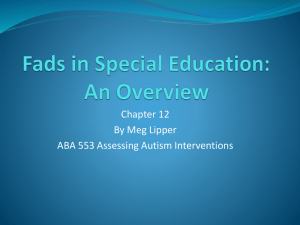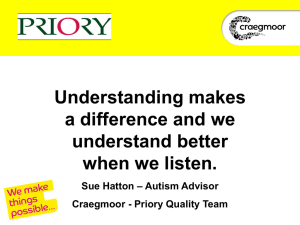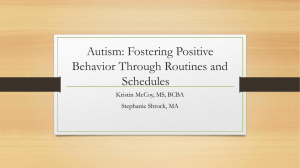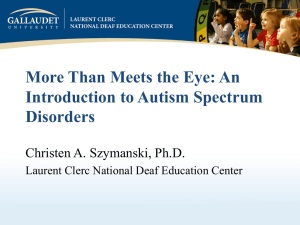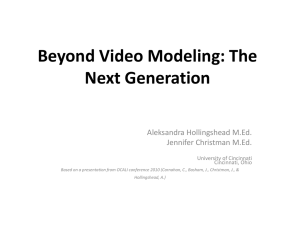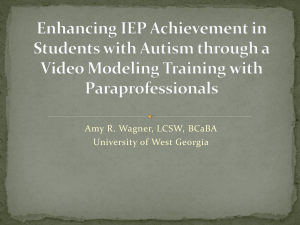Autism: A Late 20th-Century Fad Magnet
advertisement
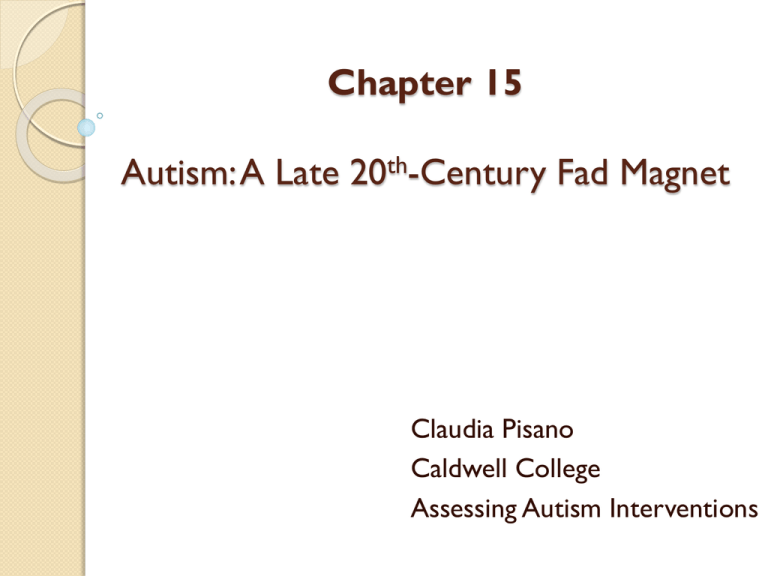
Chapter 15 Autism: A Late 20th-Century Fad Magnet Claudia Pisano Caldwell College Assessing Autism Interventions RATES OF AUTISM Researchers estimated that across the US it was 10 to 20 children per 10,000 (Jacobson, Foxx, & Mulick, 2005) Historically it was shown to be 4 to 5 children per 10,000 (Jacobson, Foxx, & Mulick, 2005) As of 2012, it is 1 in 88 children will be diagnosed with Autism (http://www.cdc.gov/NCBDDD/autism/data.html) Controversy, Fads, and Unsupported Treatments Google Search 1 hour Using the words “Autism” & “Treatment” Search Yielded 65 distinct interventions The Only Proven Treatment Interventions that are based in Applied Behavior Analysis (Jacobson, 2000) Only intervention to produce comprehensive and lasting results. The Nature of Fads Nobody creates a fad. It just happens. People love going along with the idea of a beautiful pig. It’s like a conspiracy. – Jim Henson What is a fad? Merriam- Webster – a practice or interest followed for a time with exaggerated zeal Aquirre, Quarantelli, and Mendoza (1988) defined specific characteristics of fads ◦ They are homogenous, novel, and odd Bikhchandani, Hirschleifer, and Welch (1998) ◦ Used social learning theory to describe fads Types of Fads According to Kozloff Ordinary Fads ◦ Inexpensive and harmless Pernicious Innovations In Education ◦ Passing Fads ◦ Chronic Malignancies The Parents Parents are part of the reason for the continuation of fads due to: ◦ Nature of the disorder Shotgun approach ◦ Lack of knowledge ◦ Inconsistencies among professionals The Nature of Evidence Based Intervention A lot of studies do not meet our scientific standards for evidence based practice. The suggestion is that they should be categorized as unproven and not implemented until they are established. National Autism Center Treatment National Standards Report Results Biomedical Treatments Not Directly Reported Gluten Casein Free Diet Unestablished Facilitated Communication Unestablished Auditory and Sensory Integration Unestablished Floortime Emerging TEACHH Emerging ABA Established www.nationalautismcenter.org/pdf/NAC%20Standards%20Report.pdf The Nature of Controversy Interventions are controversial if ◦ ◦ ◦ ◦ Presented as efficacious in the absence of confirming studies When pilot studies supporting them have not been replicated When treatments go farther than the data that do support them When treatment is used in an isolated fashion when multimodal approaches are needed ◦ They are packaged with so many potentially active elements that the effects of some of them are obscured or even counteracted Controversy can be an essential part to helping medicine grow The legal proceedings in which parents are fighting to have effective autism treatments provided by school and health services has been instrumental in the search for the best treatment Areas of Agreement Kabot, Masi, & Segal (2003) 6 Guidelines for Effective Treatment 1. Intervention should be started at the earliest possible age 2. Must be intensive 3. Parent training & support is critical 4. Social & Communication domains should be the foci of the intervention 5. Treatment should be systematic, built on individualized goals and objectives tailored to the child 6. An emphasis on generalization is critical to the effective intervention. Biomedical Fad Interventions Researchers generally agree that autism develops as a result of some abnormality or insult to the nervous system of developing children. ◦ Multiple developmental processes are involved ◦ Evidence does implicate several different neurochemical systems Still preliminary and tentative Biomedical Fad Interventions Several biomedical interventions with little empirical support experience popularity ◦ ◦ ◦ ◦ ◦ Pharmacologic Treatments Nutritional Fad Interventions Supplements Vaccine Link Pharmacologic Treatments Pharmacologic Treatments Dr. Fred Volkmar is a preeminent researcher in the area of medical approaches to autism. ◦ He cautions that medication treatment studies are complicated by the complexity of ASD, uncertain etiology, and methodological problems. ◦ Robust animal models of autism are lacking Current animal models tap into some aspects of autism but do not mimic the complex expression of autism in humans Animal models of disease are the foundation needed to develop efficacious and safe medications. ◦ Conclusions about medication efficacy should be approached with caution. Nutritional Fad Treatments Restriction in diet plays a role in the management of many medical disorders (Diabetes, seizures, phenylketonuria) It is reasonable that doctors and parents would consider and try nutritional interventions. Chief among dietary manipulations is the Gluten-free, Casein-Free diet, based on the “leaky gut” theory. The “Leaky Gut” Hypothesis Some children with autism have gut membranes damaged by inflammation ◦ Makes the gut “leaky” ◦ Gut cannot fully process gluten and casein Glutomophine and casomorphine cross a “leaky” gut membrane, enter the body, and cross the blood-brain barrier ◦ Interfere with neurotransmitter activity and result in increased opioid activity Incomplete breakdown of gluten and casein turns into opioid peptides ◦ Could be caused by Yeast overgrowth Immunological abnormalities Gastroenterological disease secondary to Autism. Dietary Treatments for “Leaky Guts” Aimed at restoring healthy gut flora, reducing inflammation, and sealing the “leaky” Gut ◦ GF/CF diet No gluten, no casein ◦ Specific Carbohydrate Diet Only monosaccharides (simple sugars) Some types of cheese allowed ◦ Body Ecology Diet A combination approach So far, no large scale, randomized trials of these dietary interventions, that control for confounding variables (especially maturation and diffusion of treatment) Dr. Kenneth Bock on Dietary Intervention for Autism Chelation Therapy … to be continued Mechanical Fad Interventions Facilitated Communication Auditory Integration Training Sensory Integration Training Facilitated Communication First proposed by Crossley and popularized by Biklen A form of assisted typing It was hypothesized that the technique allowed for revelation of previously untapped cognitive abilities and enabled quicker rates and more sophisticated types of learning, despite deficits in formal education. Auditory Integration Training Technique involves the use of audiograms to identify auditory hypersensitivities. ◦ Sounds are played at high, low, and hypersensitive frequencies ◦ Approximately 20 half hour session over a 10 day period. The goal is to normalize hearing and the manner in which the brain processes auditory information. Sensory Integration Training Sensory integration is a neurological process, the way the brain organizes and interprets touch, movement, body awareness, sight, sound, and gravity. Performed by an occupational or physical therapist Child is given a “diet” of sensory stimulation The “diet” consists of vestibular and tactile stimulation, purposeful movements, use of weighted vests, and brushing among other techniques. Psychosocial Fad Interventions Floortime: A Developmental, Individual Differences, Relationship-Based Approach (DIR) TEACCH (Treatment and Educational of Autistic and Communication Handicapped Children) Floortime (DIR) Developed by Dr. Stanley Greenspan ◦ Autism is an inability to relate to other affectionately in a reciprocal fashion in a variety of contexts. So, he developed his form of play therapy In the model he takes into account that each child with autism has their own strengths and weaknesses. He also states that these must be identified The “Criterion” Each child must master six foundational milestones in sequential order. When they have mastered the milestones, they will have the basic capacity for communication, thinking, and emotional coping. The Six Steps 1. 2. 3. 4. 5. 6. Self-regulation and interest in the world The formation of relationships, attachment, and engagement Reciprocal communication Complex communication Representational capacity Representational differentiation The End “Result” Children whom have progressed through these milestones can ◦ ◦ ◦ ◦ ◦ ◦ ◦ ◦ Develop a positive sense of self Engage in positive affective relationships Use language to express a variety of emotions Tolerate strong emotions without loss of control Use imagination to create new ideas Use language to express a variety of emotions Tolerate change Be flexible in dealing with people and situations How does it work? The child's actions are assumed to be purposeful. It is the parent's or caregiver's role to follow the child's lead and help him develop social interaction and communication skills. An Example A boy may frequently tap a toy car against the floor. During a Floortime session, his mother may imitate the tapping action, or put her car in the way of the child's car. This will prompt the child to interact with her. From there, the mother encourages the child to develop more complex play schemes and incorporate words and language into play. Floortime is more child-directed than some teaching methods. Its goal is to increase back-and-forth interaction and communication between child and adult. Let’s Watch and Learn! You can go through life with out being able to tie shoelaces (buy slip-ons), but who wants to go through life alone? unknown TEACCH (Treatment and Education of Autistic and Communication Handicapped Children) Founded by Eric Schopler in the Early 1970’s University of North Carolina Chapel Hill First statewide, comprehensive, community programs aimed at improving services for children with autism. TEACCH (cont.) Works with existing skills the child has Priority is structured teaching ◦ Organizing the physical environment ◦ Using visual materials so that the child can function as independently as possible without prompts from an adult ◦ Cultivating strengths and interests instead of focusing on remediation of the deficits TEACCH (cont.) Broad based and life long approach Teaches communication Teaches leisure and social skills Promotes independent works skills TEACCH also attempts to provide networks and integrate services over the lifespan. Problem with TEACCH TEACCH has been embraced by many school districts The program that is implemented in North Carolina is mandated by the legislature To the best of our knowledge, no other state has such a mandate ABA Is It a Fad? Despite the flaws in some studies, there is enough research to demonstrate the effectiveness of behavioral interventions. NY State Department of Health (1999) ◦ “…ABA programs were the only form of intervention that met the burden of demonstrating significantly positive outcomes under rigorous scientifically controlled circumstances, and constituted treatment of choice for young children with autism” Based on what we know about fads, what do you think? ABA Is It a Fad? (cont.) ABA does face problems with fads and internal controversies ◦ Recommendations for high levels of training and expertise that may be difficult to implement ◦ “Branding” of ABA programs “We do Lovaas [or] discrete trial [or] verbal behavior … therapy” Conclusion New ideas for intervention should be encouraged. However, each new idea should be rigorously tested and proven to work before it is labeled an effective treatment for children with autism. References Jacobson, J. W., Foxx, R. M., & Mulick, J.A. (Eds). (2005). Controversial therapies for developmental disabilities: Fad, fashion, and science in professional practice. Hillsdale, NJ: Lawrence Erlbaum Associates, Inc. http://www.cdc.gov/NCBDDD/autism/dat a.html



